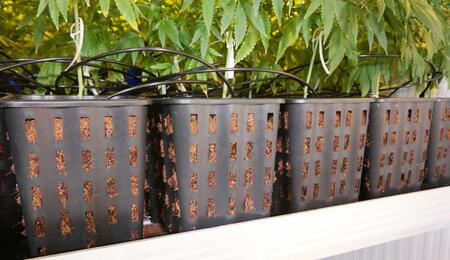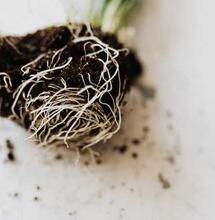What is the right pot for you?

Without question, using flower pots is the most common way of growing for gardeners who grow under artificial lighting or in a greenhouse. Since the choice of the right type has a profound impact on the efficiency of the whole cultivation process, professional growers test various types first before choosing the winner. Today, we will take a closer look at some of them.
Small, large, square, round, long, with large drainage holes, with ventilation holes, folding, textile, plastic, self-watering and who-knows-what-else can be found on the market with gardening tools. It is probably not even humanly possible to test them all, and their evaluation would hardly fit into one article. This time, therefore, I will focus on plastic flower pots with manual or capillary irrigation. They are the most common and available in many shapes, sizes, and designs. Plastic flower pots are suitable for home growers as well as large producers. They can be used repeatedly and are relatively easy to wash, disinfect and get rid of any surviving pests. In addition, they are durable, light and stable. Of course, if you want to work with only 100% natural materials, you probably prefer textile or fictile pots, but there are many limitations to these materials. They are much harder to clean, they are either heavy and easy to break (ceramics), or you have limited handling options with them. We could devote some time to flower pots made of natural materials in another article, but this time we will focus on artificial materials. [caption id="attachment_41182" align="alignnone" width="1920"] Air-Pots with ventilation openings[/caption]
Flower pot, growing medium and irrigation methods
There exists a very close relationship between the type of flowerpot, the growing medium and the method of irrigation. With that in mind, you should always choose one with respect to the other and ideally all together. For example, when using drip irrigation, smaller pots and more absorbent growing medium, such as rockwool, coco or soil, are more suitable. Larger pots are more suitable for pressure or surface irrigation and they can also accommodate lighter growing media with a higher content of perlite or expanded clay. For manual or passive irrigation, the size is not so essential, but the size of the drainage holes plays an important role. In general, for pure coco, rockwool pulp and growing media containing a lot of peat (all of which retain large amounts of water), it is preferable to use growing containers with more drainage holes, not only at the bottom but also with ventilation openings on the sides.
Flower pots with ventilation openings
Let’s discuss the ventilation openings a bit. I have tested this type of flower pots from two manufacturers: Air-Pot and Pasquini & Bini. The main task of the ventilation openings on the sides of the flowerpot is to prevent spiral growth. Thanks to this, the roots do not become entangled in each other, but spread evenly the entire volume of the flowerpot, and can thus absorb water and nutrients more efficiently and quickly. By using pots with ventilation holes, you will also prevent uneven drying of the growing medium and excessive moisture in the lower part of the pots, where there is a risk of root rot and infestation by pests. However, you can also prevent this by choosing classic flower pots with larger drainage holes or by creating a “drainage layer” on the bottom of the flower pot. [caption id="attachment_41181" align="alignnone" width="1920"] Flower pot with ventilation openings and thermal insulation foil[/caption] First, I tested the Air-Pot flower pots. You've probably come across them before. Even if not, you can have a look at them in one of the pictures in this article. These pots can be disassembled and easily stored, which is a great feature in my opinion, especially if your growing season lasts only part of the year and you don’t want to have the growing room assembled throughout the whole year. Disassembled flower pots are also easier to clean, because Air-Pots have many folds, which are relatively difficult to clean when the pot is assembled. Air-Pots are durable growing containers made of good quality materials, and I think they were the first ones to introduce a system of ventilation holes to cannabis growing community. With Air-Pots, I succeeded in having many amazing harvests. One of their great advantages is the wide range of possible applications. You can use almost any growing medium in them – soil, coco, light mixtures with a high perlite content, rockwool pulp, mapito, etc. In addition, they work great with manual, drip and pressure irrigation. There are disadvantages when growing on a larger scale, i.e. more complicated cleaning and storage. They cannot be inserted into each other when assembled and, although they are easy to assemble and disassemble, this always takes some time. [caption id="attachment_41180" align="alignnone" width="1920"] Roots in Ercole flower pot with ventilation openings[/caption] Just about three years ago I came across another flower pot with side ventilation holes. It was made by the Italian manufacturer Pasquini & Bini. Unlike Air-Pots, these are also available in a version with a square base, which I personally prefer over a round one. Why? It appears to be a more convenient shape for organizing a larger number of plants in the growing area, and this also means that the total space can be used more effectively. I heard round base pot fans claiming that the cylindrical shape allows plants to create a naturally shaped root ball. However, I haven’t noticed any signs of negative effects of the square shape when it comes to the crop. What I consider far more important is the choice of the right size with regards to the chosen method of cultivation. The Ercole range, as Pasquini & Bini flower pots with ventilation openings are called, is available in round and square versions. Basically, these are ordinary plastic flower pots that can be stacked into one another and relatively easy to clean. Compared to Air-Pots, they are cheaper and, in my opinion, more interesting for commercial use. But the main advantage for all growers is their low price. Ercole is suitable for all the already mentioned growing media, but, of course, they also have some weak spots. For example, Pots with a square base are not very suitable for a combination of less compact growing medium and manual irrigation. The reason is that the ventilation openings are relatively large and heavier manual watering can wash off parts of the growing medium through the ventilation openings. Square pots called Square Super Ercole are good for drip and pressure irrigation, while round types can be also used for manual irrigation, because they have slightly smaller ventilation openings.
Classic flower pots with drainage holes
Surely, there is no need to introduce black plastic flower pots. They are suitable for lighter growing media, including pure expanded clay. You don't have to be bothered with the question of choosing the right irrigation system, because these pots can be used for manual, capillary, surface and pressure irrigation. Besides, their cleaning and storage is very easy. They are also suitable for growing in denser growing media with higher water retention capacity, such as soil, coconut or rockwool, but they are several shortcomings in this respect. For example, even when choosing pots with large drainage openings, the growing medium may not dry out evenly. What is more, the roots do not have balanced conditions in the whole pot and the development of the root system may be worse than in pots with ventilation holes. The roots also often grow in a spiral and become entangled in each other, which to some extent limits their ability to absorb nutrients (one part of the root hair is pressed against another root or wall). In any case, it must be said that choosing this type of pots is not a mistake. It is possible to use almost any substrate and any irrigation system with them. Simply put, they are perfectly versatile. [caption id="attachment_41179" align="alignnone" width="1446"] Air condition exhaust in the flower pot area[/caption]
Temperature of the growing medium
A significant issue when growing in pots is the temperature of the growing medium because it has a critical impact on proper development of the root system and the roots’ ability to absorb nutrients. In closed growing spaces and greenhouses, the air temperature is usually between 24 and 30 °C. However, root development and nutrient absorption are ideal at temperatures between 18–20 °C. If we consider this high temperature in the growing space and the fact that most pots are black and thus capture even more light, heating the pots even more, it is clear that the temperature of the growing medium should be somehow regulated. Watering is an important factor in lowering the temperature in flowering pots. According the above mentioned data, we can say that the ideal temperature of the nutrient solution is 18–20 °C. Some growers also use other sources than water to keep the temperature of the growing medium lower. One of them is the thermal insulation cover of the pots, which not only reflects the incoming light, but also insulates the pot from the heat in the growing room. As a result, the growing medium, which has been cooled by water, heats up again more slowly, and the ideal temperature is easier to maintain even between individual irrigation cycles. Another way to keep the growing medium cooler is to direct air conditioning vents to the area close to the pots. Although this method works well, the question is what the disruption of the air circulation in the growing room could cause. The cold air sticks to the ground, while the warm air is pushed up. Under normal circumstances, therefore, cold air from the air conditioner is released above the plants. It then naturally descends through the vegetation as the warm air is pushed upwards. Therefore, some growers have two levels to which they push the cool air from the air conditioner - one above the plants and the other above the flower pots. If you do not use air conditioning, you can cool the pots at least by supplying cooler air inside the growing room from the outside, above the level of the growing containers. Make sure to provide the air supply with at least a basic air filter to prevent impurities from entering the growing room. Mr. José info@mrjose.eu



.png)
